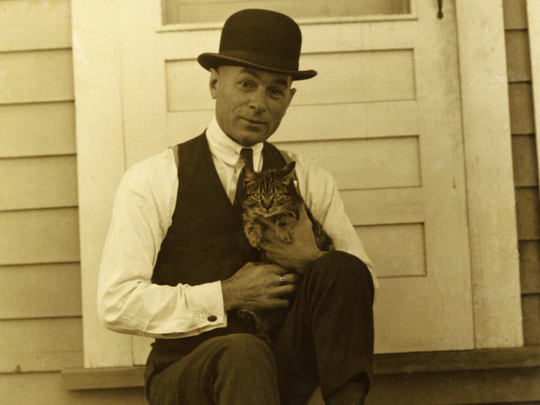
Krazy: George Herriman, a Life in Black and White
By Michael Tisserand, Harper, 560 pages, $35
In our superficially more enlightened age, the phrase “mixed race” has become the accepted term to describe people with parents of different races. In fact the phrase has become a tool of marketers and brand-conscious celebrities to suggest whatever they’re selling is all-inclusive, a living embodiment of diversity. Many take great care in, for example, their Instagram biographies to list their hyphenated backgrounds.
But there are limits to the term’s utility, especially for people with African ancestry. Barack Obama was America’s first mixed-race president. His father was Kenyan and his mother a white woman from Kansas. Yet the tawdry racial history of the Republic demanded that he claim blackness as his primary identity because one drop of black blood has always decided your fate in the country. “Mixed race” notwithstanding, an African heritage in America is never just a cool exotic spice; one taste and it becomes all anyone remembers of the meal.
This rigid attitude towards race is often enforced by black Americans as fiercely as whites. For them the “mixed race” label, when employed by black people with a non-black parent or grandparents, seems more a transparent attempt to dodge racial pigeonholing than a heartfelt assertion of identity. Jim Crow, which ended officially in the 1960s, has never been completely dismantled. So attempts to escape its grip, while understandable, create resentment in those unable to slip across the racial boundaries.
All of which makes Michael Tisserand’s “Krazy: George Herriman, a Life in Black and White” a fascinating and frustrating biography. Though Herriman’s “Krazy Kat” comic strip was admired in his lifetime, it wasn’t until years after his death in 1944 that his vast influence received widespread critical respect. Herriman’s depiction of the tangled relationships among the black cat Krazy, his white mouse tormentor and sometime love interest Ignatz and the bulldog Officer Pupp, set against a desert backdrop in fictional Coconino County (taken from a real area of Arizona), inspired several generations of cartoonists. Charles M. Schulz’s “Peanuts,” Ralph Bakshi’s “Fritz the Cat” and Art Spiegelman’s “Maus” all owe a debt to Herriman’s draftsmanship and poetic sense.
Schulz got turned on to “Krazy Kat” right after the Second World War, he said, and it “did much to inspire me to create a feature that went beyond the mere actions of ordinary children.” Theodor Geisel (Dr. Seuss), whose animal characters strongly resemble Herriman’s, told a biographer, “At its best, the comic strip is an art form of such terrific wumpf! that I’d much rather spend any evening of any week rereading the beautifully insane sanities of George Herriman’s ‘Krazy Kat’ than to sit myself down in some opera house to hear some smiling Irish tenor murdering Pagliacci.” The iconoclastic Robert Crumb called Herriman the “Leonardo da Vinci of comics”, while the ambitious Spiegelman argued that “Krazy Kat” “crossed all kinds of boundaries, between high and low, between vulgar and genteel”. All this alone would have made Herriman worth serious study.
But then in the early 1970s, a quarter-century after his death, a birth certificate was found stating that Herriman was born “coloured” to Creole parents in that 19th-century hotbed of miscegenation, New Orleans. Clearly his work had to be re-examined. Not to question its genius, but to see how much of it dealt with hiding a huge part of himself in plain sight. He lived as a white man for decades in the surprisingly benevolent employment of William Randolph Hearst, who adored Herriman’s art. He married a white woman, Mabel Bridge, and was able to purchase property in Los Angeles areas where racist covenants kept obviously black Angelinos out.
“I never saw any indication in pigmentation, facial structure or speech inflection that indicated anything Negroid about George Herriman,” his friend and fellow cartoonist Karl Hubenthal said. Among his newspaper colleagues there was a jokey guessing game about his racial lineage inspired by his “knotty” (aka kinky) hair. Sometimes referred to as George the Greek, he took to wearing hats religiously: of the 15 photographs “Krazy” includes of Herriman, 12 show him in a hat.
Writing the biography of a black person who passed for white in 20th-century America adds an extra layer of difficulty to the detective work any biographer must undertake. This is especially true since Herriman seems never to have addressed his deception in his personal writings or confided his feelings about racial identity to family or friends. He claimed he came from a family of bakers and had worked in his youth as a house painter and carnival barker. In truth he was the great-grandson of Stephen Herriman, a married white boat’s captain from Long Island with roots in England, who purchased enslaved workers after settling in Louisiana, and Justine Olivier, a “free woman of colour” who engaged in a plaçage relationship in which her lover financially supported her and her two children.
Herriman’s grandfather George became a successful tailor with a shop in the heart of the French Quarter; his son, George Jr, followed him into the tailoring business. Through the Civil War and the ensuing retrenchment of the freedoms Creoles enjoyed in Louisiana, the Herrimans became prominent in New Orleans’s Creole community, joining the Masons and supporting court cases to stem the tide of segregation overrunning Louisiana and the South during Reconstruction.
George Joseph Herriman, the cartoonist, was born on August 22, 1880, in the Creole stronghold of Tremé. Of his childhood, he “usually said he was from California”, Tisserand writes. “But it’s likely that he grew up with a degree of comfort and stability, even as the adults around him were becoming less sure of their social and economic footing.” So in August 1890 Herriman’s father purchased tickets for himself, his wife and their four children for a train ride to the promised land of California. Young Herriman was 10 at the time, old enough to be aware of the colour line that defined American race relations.
At some point during this fateful journey west, the Herriman family shifted from “coloured” to “white”. As his father found work as a tailor with a number of Los Angeles shops, young George attended Catholic school and became attracted to drawing as an adolescent. His assumed non-black identity, in a sense, probably fed his creativity, since Herriman would spend the rest of his life concocting variations on his origin story. “Once, when a youth, I aspired to become a baker, a kneader of dough, to mould bread and fashion a doughnut or stencil a cookie,” he wrote in 1926. “Full of the spirit of adolescence I buried a dead mouse in a loaf of bread once — it found its way into a tough family and not only did I get a sweet trimming but I got the air also ... Then I became a cartoonist — as a sort of revenge on the world.”
Absent any direct commentary on Herriman’s dual identity, Tisserand promises to sift through the cartoonist’s work to parse his relationship to race. In the first chapter the author asks, “Did this revelation, whatever it was, find its way into his wondrous comics?” Early in his career, as a sports cartoonist for the Hearst newspaper syndicate, Herriman championed the rebellious black heavyweight Jack Johnson. While the Hearst papers’ front pages incited racial hatred of the black fighter typical of the time, Herriman, and some of his sports page colleagues, supported Johnson with surprising vigour.
Accompanying a January 1909 drawing titled “A Barnyard Study in Black and White”, which depicted Johnson as a plantation overlord, Herriman wrote an essay that joked: “The country reverberates with the brave cry of ‘The title must come back to the Caucasian.’ ... They clang their tin armour and puff their age-worn breasts and acclaim themselves Davids ready to crack the dome of sombre-hued heavyweight Goliath to bring back our fair title to its home.”
The day after Johnson defeated the former champ Jim Jeffries, Tisserand notes, Herriman drew a “massive pen-and-ink minstrel show titled ‘Uncle Tom’s Cabin — 1910’. It is a fantasy of racial revenge: a grinning, long-limbed Uncle Tom knocks out a tiny Simon Legree. ‘Times hab changed Simon,’ gloats Tom.”
Though Tisserand does a truly exhaustive job detailing Herriman’s private and public lives, the promised analysis of race in his vast catalogue of “Krazy Kat” cartoons is more fleeting than intricate. It feels scattershot even when he identifies potentially relevant material, as with a cartoon published on April 18, 1937, in which Krazy Kat encounters a “pale, even unearthly white” baby bear. “Krazy and the bear talk,” Tisserand writes, “and Krazy grows confused as to the bear’s identity.” Krazy discovers the “equatorial bear” has a mother from the South Pole and a father from the North Pole, and that his parents met halfway at the equator. Krazy’s parting line is “Happy mittin’ on the equator — is all I can say.”
I wonder if a critic more sensitive to the nuances of race (perhaps Ishmael Reed, who dedicated the magnificent 1972 novel “Mumbo Jumbo” to Herriman) would have found more fodder in the “Krazy Kat” catalogue than Tisserand. That said, “Krazy” is absolutely an essential companion to any deep dig into Herriman’s work via the many critical books and blogs on comics and, of course, the original “Krazy Kat” cartoons in anthologies and online.
–New York Times News Service
Nelson George is the author, most recently, of “The Hippest Trip in America: Soul Train and the Evolution of Culture and Style”.









